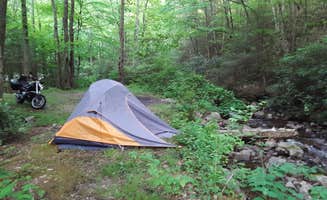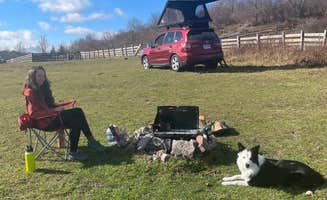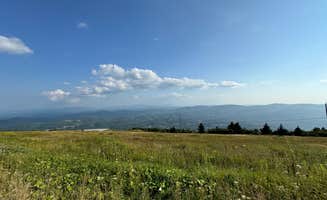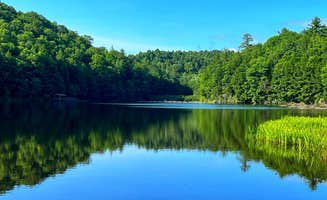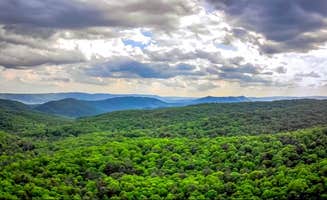Dispersed camping near Elk Creek, Virginia offers primitive sites throughout the Jefferson and George Washington National Forests. Most locations sit at elevations between 2,000-5,000 feet, creating distinct seasonal camping conditions with cool summer nights even when valley temperatures climb. These free camping spots require visitors to pack in all supplies and pack out all waste.
What to do
Fishing opportunities: Little Tumbling Creek provides several creek-side camping spots with easy fishing access. "Waterfalls on way up and good fishing along the way in tumbling creek," notes a camper at Little Tumbling Creek.
Trail exploration: The Appalachian Trail crosses through multiple dispersed camping areas. A camper at Walnut Flats mentions "trail right through the campground and the Apalation trail just across the road," making it convenient for day hikes.
Mountain biking: The Virginia Creeper Trail offers 17 miles of mostly downhill riding from Whitetop Mountain. This popular route attracts cyclists of all skill levels who can arrange shuttle services in nearby Damascus.
Wildlife watching: Wild ponies frequent certain areas, particularly near salt licks. A camper at Scales Trailhead Basecamp shares that "the campground itself is great! It's right on the AT, so there are lots of through hikers that you'll see stop in for a night. That also means that there's lots of great hiking options! Our favorite parts are the beautiful views, wild ponies."
What campers like
Sunrise views: Camping at higher elevations provides remarkable morning views. A Whitetop camper reports, "We got to the top of the mountain and decided to camp near a crop of trees...The next morning was still foggy. As we're getting ready to head out for the day, all of a sudden the sun came out and we were ABOVE THE CLOUDS."
Creek sounds: Many campers appreciate the natural soundtrack at streamside sites. One Mount Rogers National Recreation Area visitor described their experience: "Beautiful spot, right next to a gorgeous creek. It was totally empty in March - we didn't see a single soul. Got a beautiful campsite right on the creek."
Star viewing: The minimal light pollution creates excellent stargazing conditions. A Mount Rogers camper noted "The night sky was one of the most memorable moments from our trip. I've never seen so many stars!"
Solitude: Many sites offer true seclusion, especially midweek or during shoulder seasons. "We spent 1 night out here on a Saturday Night it is very secluded away from everything," reports a camper at Washington & Jefferson National Forest Dispersed Sites.
What you should know
Road conditions: Access roads to many sites require careful driving. A visitor to Whitetop advises: "The road to this site is WILD, but doable! I'll leave photos of the worst spots to help you decide whether or not you should drive up to the top. We drove our 2WD Ford Maverick up the rocky road and it handled it just fine."
Cell service: Most dispersed camping areas have no connectivity. A Little Tumbling Creek camper reports: "Absolutely no verizon service at the site." Plan accordingly for emergency communication.
Weather preparation: Mountain weather changes quickly, especially at higher elevations. Whitetop campers note: "The wind is killer. Very little Verizon and AT&T signal." Bring proper gear for wind, rain, and temperature fluctuations.
Trash management: Unfortunately, some sites suffer from litter problems. A Washington & Jefferson National Forest camper shared: "The only major problem is that folks tend to leave a ton of trash around, so we often spend about 20-30 minutes cleaning these sites upon arrival. Please Leave No Trace!"
Tips for camping with families
Established sites: For camping with children, consider sites with some amenities. Walnut Flats offers "five established camp sites with fire rings and picnic tables. The bathroom is a pit style but it was still clean and didn't smell."
Water sources: Families need reliable water access. While creeks provide filterable water, some sites like Walnut Flats have pumps: "well water pump for drinking water but didn't use it."
Safety considerations: Choose sites with appropriate access for your family's needs. Some areas require significant hiking while others allow direct vehicle access: "This is a small campsite that I believe is on hunting land. You pass a sign going in toward it that states as much. There are two private properties on the road, and you basically just follow it back until you get to this clearing. Pretty large clearing to set up a tent or tents."
Wildlife awareness: Teach children about maintaining safe distances from wild ponies and other wildlife. These animals are wild despite their sometimes friendly appearance.


